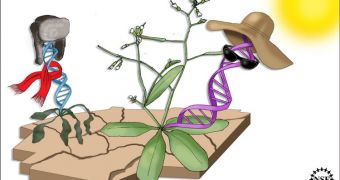Investigators at the Brown University have recently determined in a new study that plants may not be entirely helpless in the face of climate change, as many previously thought. While animal species can move to new environments, vegetation apparently prefers to adapt its genetic code to face challenges.
As global warming starts to make its effects felt more and more around the world, plants are some of the worst-affected organisms. If a certain species of trees has evolved to occupy an environment, then it is perfectly adapted to fulfill this role.
However, if the conditions inside the environment change, the species need to change themselves. More evolved animals prefer to leave the area, whereas plants may use their genomes to produce changes that would enable them to survive further.
In the new study conducted at Brown, investigators analyzed the genetic behavior of Arabidopsis thaliana, a common European plant that provided tantalizing clues of how plants may respond to global warming in past studies.
Details of the new investigation were published in the October 7 issue of the top journal Science. The study shows how the plant decides which genes to pass down from a generation to another, so that the offspring may be better able to survive in a particular set of conditions.
“This is the first study to show evolutionary adaptation for Arabidopsis thaliana on a broad geographical scale and to link it to molecular underpinnings. Climate is the selective agent,” explains one of the paper authors, research scientist Johanna Schmitt.
She also holds an appointment as the director of the Environmental Change Initiative at the university. The expert says that discovering a mechanism through which climate conditions influence the expression of genes inside this plant would be a remarkable discovery indeed.
“There is still evolutionary flexibility to help plants take one direction or another. It gives us good hope to see, yes, it’s adapting,” adds the first author of the Science paper, Brown postdoctoral student Alexandre Fournier-Level.
In the experiments the team conducted, the behavior of the test plant was analyzed in a variety of climates, including cold (Finland), warm (Spain), oceanic (United Kingdom) and continental (Germany). The plant is spread and adapted to living nearly anywhere in Europe.
The new study “was a truly massive undertaking, tracking more than 75,000 plants in the field, from near the arctic circle to the Mediterranean coast,” Deep Springs College expert Amity Wilczek says. She is a former postdoctoral researcher in Schmitt’s lab.
“Arabidopsis is an annual plant, so we could measure total lifetime success of an individual within a single year. We gathered plants from a variety of native climates and grew some of each in our four widely distributed European garden sites,” the expert adds.
“We shipped our harvested plants back to Brown and began the laborious task of counting fruits on these plants. In the end, we were able to assemble a very large and comprehensive dataset that gives us new insight into what it takes for a plant to be successful in nature under a broad range of climate conditions,” Wilczek concludes.
The bulk of the funds needed for this investigation came from the US National Science Foundation (NSF) and the Alexander von Humboldt Foundation.

 14 DAY TRIAL //
14 DAY TRIAL //